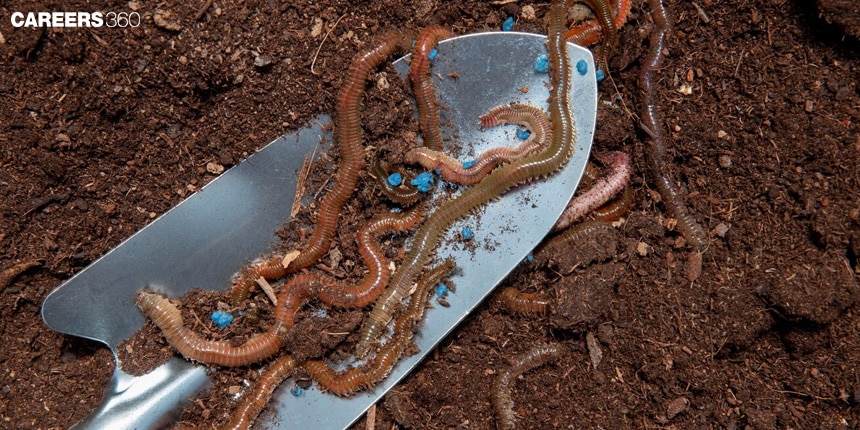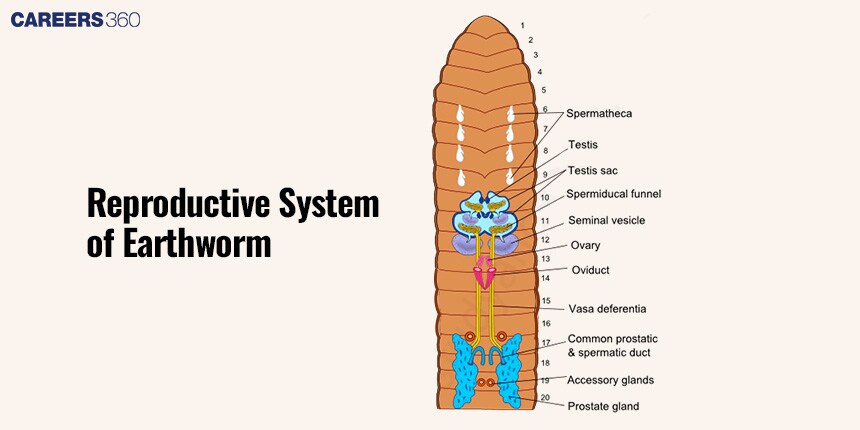Reproductive System of Earthworm: Definition, Characteristics, Classification, Examples, Structure
What Is Reproductive System Of Earthworm?
Earthworms are highly invaluable in the maintenance of healthy ecosystems and, specifically, in enhancing the fertility and structure of soils. Ultimately, it is their ability to aerate soils, decompose organic matter, and cycle nutrients that makes them such a valuable prize for agriculture and natural surroundings. Knowledge of the earthworm reproductive system is critical because that process has a significant effect on population dynamics and ecological functions.
NEET 2025: Mock Test Series | Syllabus | High Scoring Topics | PYQs
NEET Important PYQ's Subject wise: Physics | Chemistry | Biology
New: Meet Careers360 B.Tech/NEET Experts in your City | Book your Seat now
- What Is Reproductive System Of Earthworm?
- Anatomy Of Earthworms
- Reproductive Organs In Earthworms
- Significance In Ecology
- Recommended video on Reproductive System of Earthworm

Anatomy Of Earthworms
The body of an earthworm is cylindrical, segmented, and made up of many segments called annuli.
Each segment, except the first and the last one, bears small projections of bristle-like structures that help in locomotion and holding it to the soil.
The clitellum represents a thickened, glandular region of the body, located about the 32nd to 37th segment.
It is more prominent or conspicuous and appears lighter in colour. It participates in crucial aspects of the reproductive process in cocoon formation.
The earthworm's digestive system includes a mouth, pharynx, oesophagus, crop, gizzard, and intestine.
It is crucial in breaking down organic matter and nutrients for their reproductive activities by making sure they are well-endowed with energy and materials.
Internally, earthworms display a segmented body plan in which each segment is a repeated structure containing repeated organs and features.
Segmentation allows for effective locomotion through concerted coaxial muscle contractions, especially during copulation.
Reproductive Organs In Earthworms
Worms have two pairs of testes in segments 10 and 11, respectively, which produce the sperm cells.
Seminal vesicles are large, sac-like structures in which the sperm mature and await emission during copulation. These are located in segments 9-12.
Sperm ducts transport the mature sperm from seminal vesicles to the male genital pores found in segment 15.
Ovaries are found in segment 13, and ovaries produce eggs.
Oviducts conduct eggs from ovaries to Female genital pores located on segment 14.
An earthworm is hermaphrodite; this means it has both male and female reproductive organs. However, they normally undergo cross-fertilisation.
The cocoon consists of fertilised eggs and is deposited in the soil. The eggs hatch into juvenile worms inside the cocoon in the appropriate conditions and with the support of adequate nutrition in the early stages of development.
Diagram: Reproductive Organs In Earthworms
The given diagram shows the reproductive organs located in different body segments of an earthworm.

Significance In Ecology
During digestion, earthworms break down organic matter and pass it out of their bodies, thus fertilising the soil. Their burrowing allows aeration of the soil, enhancing water infiltration and allowing root growth of plants.
Data on the reproductive success and population dynamics of earthworms provide information related both to soil health and environmental quality. Healthy, fertile soils are nearly always associated with a high population of earthworms, while poor soils—sterile or very poor in nutrients—are witnessing low populations of earthworm populations.
Understanding the earthworm reproductive system underlines their essence to ecosystems, essentially in maintaining soil health. Their strategies of reproduction ensure population stability and, hence, a contribution toward ecological equilibrium. This knowledge about their biology and reproductive processes underlies major ramifications for agriculture, ecology, and environmental management by promoting measures aimed at maintaining fertile and sustainable soils.
Recommended video on Reproductive System of Earthworm
Frequently Asked Questions (FAQs)
The clitellum secretes a mucous ring that forms the cocoon for fertilized eggs and also helps in the development of reproductive organs.
The best conditions for the reproduction of earthworms include moist soil with moderate temperatures and an abundance of organic matter for food.
The conditions which bring about the hatching of earthworm eggs are usually fulfilled after 2-3 weeks, depending on conditions of weather, temperature, and moisture content.
Earthworm reproduction facilitates improvement in the fertility and structure of the soil, so it supports sustainable agriculture by implication, from better nutrient cycling and health in soils.
Yes, earthworms lay eggs inside cocoons, and these cocoons are laid in the soil, where the drying out of the cocoon inhibits the development of the contained eggs into juvenile worms.
Also Read
29 Nov'24 12:52 PM
26 Nov'24 04:23 PM
26 Nov'24 04:19 PM